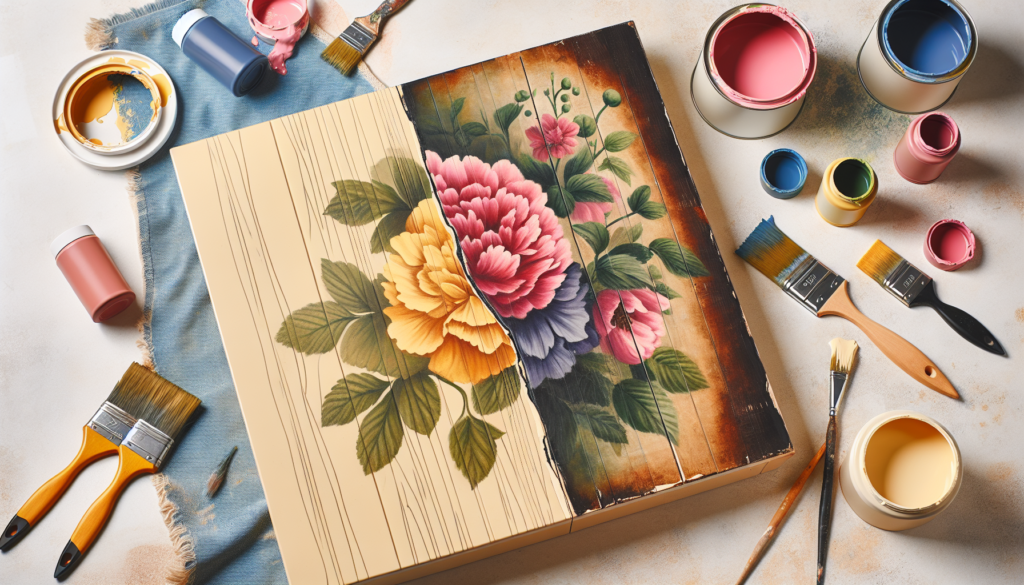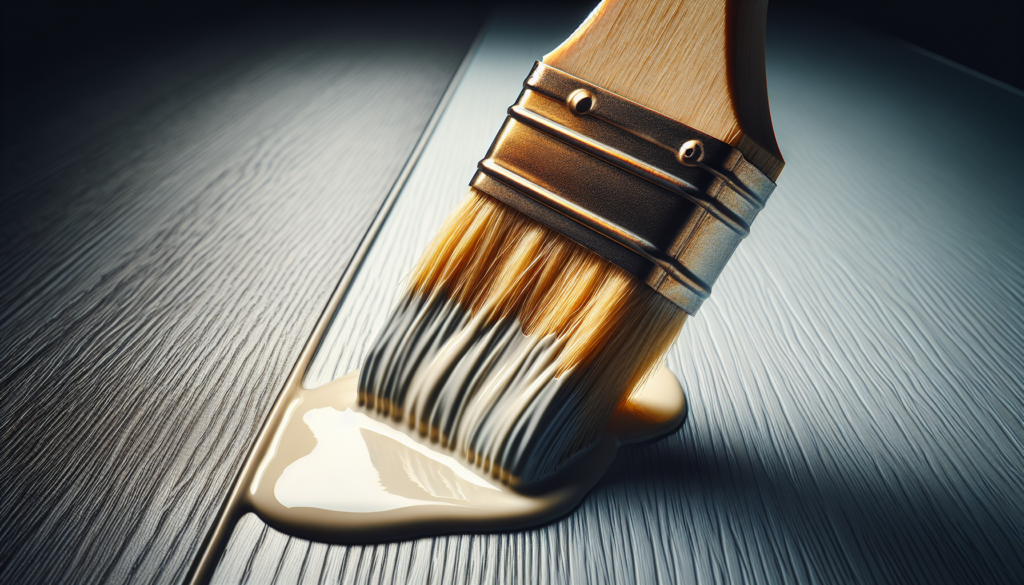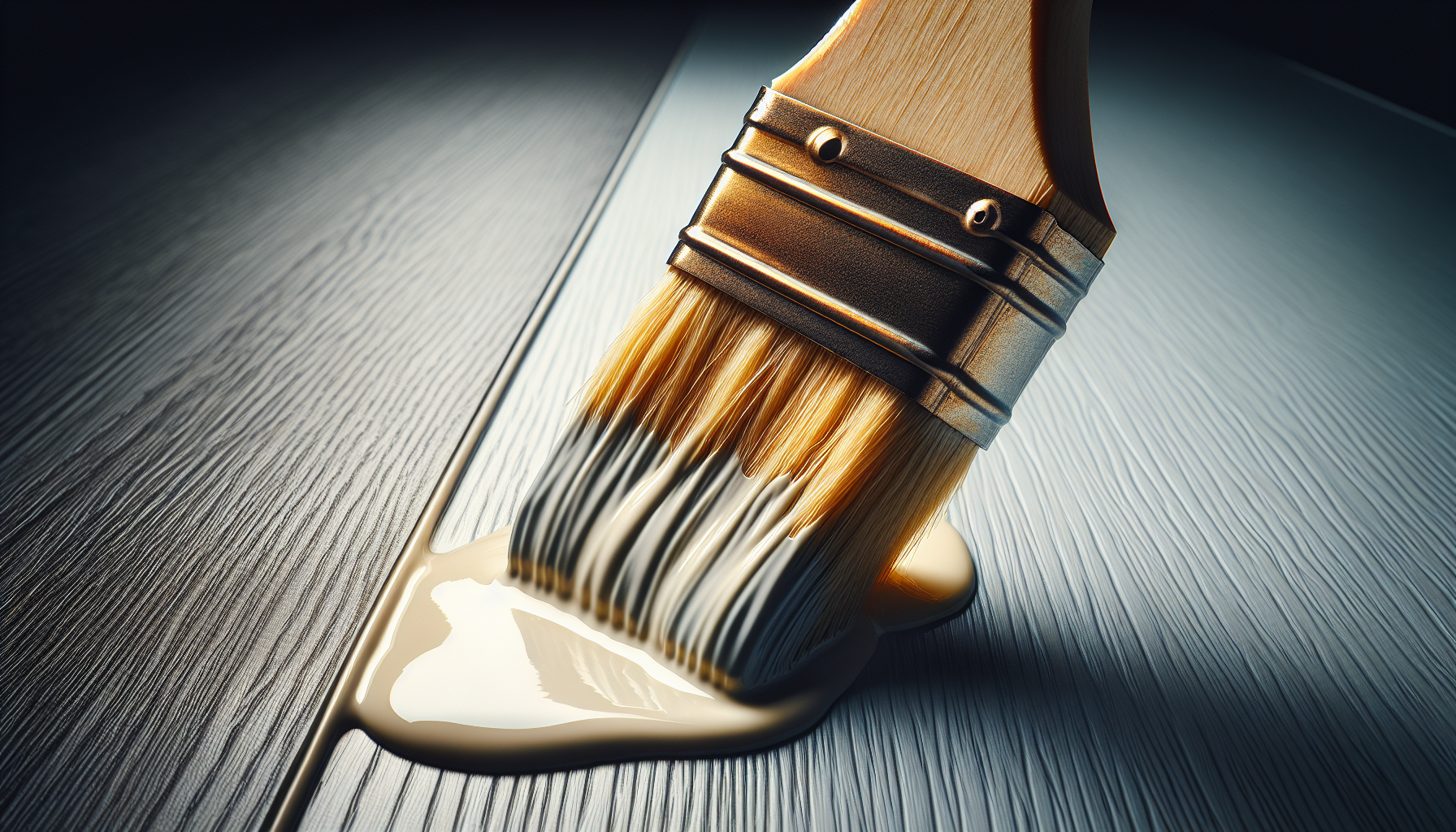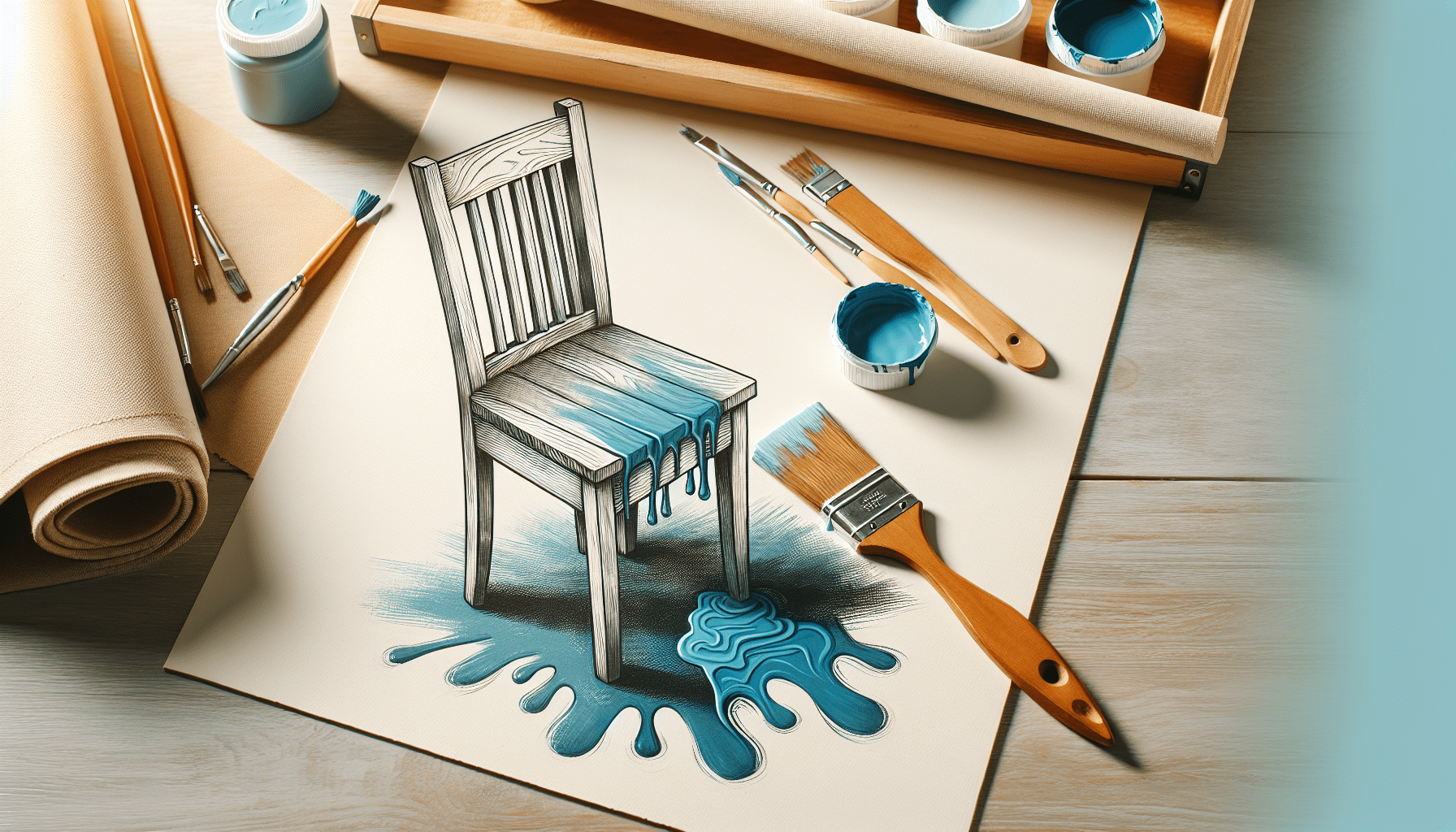Chalk paint has become increasingly popular in the world of furniture restoration and DIY projects. However, when it comes to laminate surfaces, the question arises: Can you chalk paint laminate? If you have ever wondered whether this versatile paint can transform your laminate furniture or countertops, you’re not alone. In this article, we will explore the possibilities, limitations, and techniques of chalk painting laminate, providing you with all the information you need to confidently embark on your next home improvement endeavor.
Can You Chalk Paint Laminate
When it comes to transforming the appearance of laminate surfaces, you may wonder if using chalk paint is a viable option. Chalk paint, known for its matte finish and vintage charm, has gained popularity in the world of home decor and furniture refinishing. However, it is important to understand the nature of both chalk paint and laminate surfaces before attempting to use them together.
What is Chalk Paint
Chalk paint is a type of paint that is known for its unique characteristics. It is typically made with water, calcium carbonate, pigment, and other additives that give it a thick consistency and a matte, chalky finish. Unlike traditional paint, chalk paint does not require sanding or priming before application, as it adheres well to most surfaces.
Understanding Laminate Surfaces
Laminate surfaces, on the other hand, are made from layers of synthetic materials that are pressed together under high heat and pressure. They are commonly used for countertops, cabinets, and furniture, as they are durable, affordable, and come in a variety of designs and colors. While laminate surfaces are known for their smooth and glossy appearance, the non-porous nature of laminate can make it challenging for paint to adhere properly without proper preparation.
Preparation
Before embarking on your chalk painting journey, proper preparation is essential to ensure a successful outcome. This involves cleaning the laminate surface, removing any hardware or fixtures, covering surrounding surfaces to protect them from paint splatters, ensuring proper ventilation, and wearing protective gear such as gloves and goggles.
Choosing the Right Type of Chalk Paint
When it comes to chalk paint, there are various brands and formulations available in the market. When selecting the right type of chalk paint for laminate surfaces, it is important to consider its adhesion properties, durability, and compatibility with laminate. Some chalk paints are specifically designed for use on laminate and other non-porous surfaces, ensuring better adhesion and longevity.
Gather the Necessary Materials
To successfully chalk paint laminate, it is important to gather the necessary materials beforehand. This includes chalk paint, painter’s tape, paint brushes and rollers suitable for chalk paint, sandpaper and a sanding block, primer specifically formulated for laminate, drop cloths or plastic sheets to protect surrounding surfaces, cleaning supplies to prepare the laminate surface, and appropriate protective gear.
Cleaning the Laminate Surface
Before applying chalk paint to laminate, it is crucial to clean the surface thoroughly to remove any dirt, grease, or residue that may hinder paint adhesion. Start by dusting off the surface using a soft cloth or vacuum cleaner. Then, mix a mild detergent or trisodium phosphate (TSP) solution with water and use a clean cloth to wipe down the laminate surface, ensuring all areas are cleaned properly. Finally, dry the surface completely before proceeding with the next steps.
Sanding the Laminate
Sanding the laminate surface is an important step to enhance paint adhesion. Lightly sanding the laminate creates a rough texture that allows the paint to grip onto the surface better. Use a sanding block or sandpaper with a fine grit (around 150-200) and gently sand the entire surface in a circular motion. After sanding, remove any sanding residue with a damp cloth or vacuum cleaner.
Priming the Laminate
Priming the laminate surface is crucial to ensure proper adhesion and prevent the paint from chipping or peeling over time. Choose a primer specifically formulated for use on laminate surfaces. Apply a thin, even coat of primer using a brush or roller, following the manufacturer’s instructions. Allow the primer to dry completely before proceeding with the next steps.
Applying Chalk Paint to Laminate
Once the laminate surface has been properly cleaned and primed, it is time to apply the chalk paint. Use a brush or roller suitable for chalk paint and apply thin, even coats of paint, allowing each coat to dry completely before applying the next. Depending on the desired coverage and color intensity, multiple coats may be required. Ensure that the paint is applied evenly to achieve a smooth and professional finish.
Sealing and Finishing
To protect the chalk paint on laminate and ensure its longevity, it is important to seal and finish the painted surface. There are various options for sealing chalk paint on laminate, such as wax, polyurethane, or a water-based sealer. Apply the chosen sealer according to the manufacturer’s instructions and allow sufficient curing time before using or placing objects on the painted laminate surface.
What is Chalk Paint
Definition and Characteristics
Chalk paint is a type of paint that has unique characteristics compared to traditional paint. It is made with water, calcium carbonate, pigment, and other additives that give it a thick and creamy consistency. Chalk paint dries to a matte, chalky finish, reminiscent of vintage aesthetics. It is known for its ease of use and ability to adhere to various surfaces without the need for sanding or priming.
Advantages of Chalk Paint
There are several advantages to using chalk paint in your DIY projects. Firstly, as mentioned earlier, chalk paint does not require extensive surface preparation. It adheres well to most surfaces, including wood, metal, and even laminate. Secondly, chalk paint offers a wide range of color options, allowing you to unleash your creativity and customize your projects according to your style preferences. Lastly, chalk paint provides a distinct matte finish that can add a touch of elegance and charm to your furniture or decor pieces.
Versatility in Usage
Chalk paint’s versatility makes it suitable for various projects and surfaces. It can be used to transform worn-out furniture, update outdated kitchen cabinets, or add a vintage touch to home accessories. Whether you are an experienced DIYer or a beginner, chalk paint can be a great option for giving your projects a fresh and unique look. Keep in mind that proper surface preparation and the use of suitable sealants are key to achieving lasting and aesthetically pleasing results.

Understanding Laminate Surfaces
Definition of Laminate
Laminate is a synthetic material commonly used in home construction and furniture making. It consists of multiple layers of paper or fiberboard impregnated with resin and finished with a protective layer. Laminate surfaces are known for their durability, affordability, and versatility in design. They can mimic the appearance of various materials, such as wood or stone, making them a popular choice for countertops, cabinets, and flooring.
Properties of Laminate
Laminate surfaces offer several desirable properties. They are resistant to scratches, stains, and moisture, making them suitable for high-traffic areas. Laminate is also relatively easy to clean and maintain. However, one of the challenges of using traditional paint on laminate is its non-porous nature, which can result in poor adhesion and paint peeling over time.
Common Uses of Laminate
Laminate is widely used in residential and commercial settings. In homes, it can be found in kitchens as countertops and cabinets, bathrooms as vanity tops, and living areas as flooring or furniture surfaces. In commercial spaces, laminate is commonly used for office furniture, restaurant tables, and retail displays. Its versatility, affordability, and durability make it a popular choice for various applications.
Typical Issues with Chalk Painting Laminate
While chalk paint can be applied to laminate surfaces, there are certain challenges that may arise. Due to the non-porous nature of laminate, paint adhesion can be an issue if the surface is not properly prepared. Without proper cleaning, sanding, and priming, the paint may not adhere well and may easily chip or peel off. Therefore, it is important to follow the appropriate steps and use suitable materials to ensure a successful and long-lasting chalk painting project on laminate surfaces.
Preparation
Cleaning the Laminate Surface
Before applying chalk paint to laminate, it is crucial to prepare the surface properly. Start by removing any dust or debris from the laminate using a soft cloth or a vacuum cleaner. This will ensure that the paint adheres evenly to the surface. Next, mix a mild detergent or trisodium phosphate (TSP) solution with water and use a clean cloth to wipe down the laminate surface, removing any grease, oil, or residue. Make sure to clean all areas thoroughly, including edges and corners.
Removing Hardware and Fixtures
If you are planning to chalk paint furniture or cabinets with removable hardware, it is recommended to remove them before painting. This will make the painting process easier and prevent the paint from getting on the hardware or fixtures. Use a screwdriver or appropriate tools to carefully remove hinges, knobs, handles, or any other removable parts. Keep them in a safe place so they can be reattached once the painting is complete.
Covering Surfaces to Protect
To prevent accidental paint drips or spills, it is important to protect surrounding surfaces. Use drop cloths or plastic sheets to cover the floor, countertops, or any other areas that may come into contact with paint. Secure the covers properly to ensure they stay in place during the painting process. Additionally, use painter’s tape to cover edges or areas that you want to keep paint-free, such as adjacent walls or trim.
Room Ventilation and Safety Measures
Proper ventilation is essential when working with paint. Make sure to open windows or doors to allow fresh air to circulate in the room. If possible, use fans or air purifiers to further improve air circulation. Additionally, it is important to wear appropriate protective gear, such as gloves, goggles, and a mask, to protect yourself from paint fumes and potential skin or eye irritation. Follow the manufacturer’s instructions on the paint container for any specific safety guidelines.

Choosing the Right Type of Chalk Paint
Exploring Different Brands and Formulations
When it comes to chalk paint, there are numerous brands and formulations available in the market. Each brand may offer different characteristics, such as variations in color selection, finish options, and consistency. It is recommended to explore different brands and read reviews to find the one that best suits your project needs. Some brands also offer chalk paint specifically formulated for use on laminate and other non-porous surfaces, ensuring better adhesion and durability.
Considerations for Laminate Surfaces
When selecting chalk paint for laminate surfaces, there are a few factors to consider. Look for a paint that has good adhesion properties and is suitable for non-porous surfaces. Some brands may have specific recommendations for painting laminate, so it is beneficial to check their instructions or consult with a paint specialist. It is also important to consider the color and finish options available, as they can greatly influence the overall look and feel of your project.
Gather the Necessary Materials
Chalk Paint
Be sure to select the appropriate amount and color of chalk paint for your project. Consider the surface area you will be covering and any additional coats that may be required for optimal coverage. It is recommended to purchase a little extra paint to account for touch-ups or future projects.
Painter’s Tape
Painter’s tape is essential for creating clean lines and protecting areas that should not be painted. Use painter’s tape to cover edges, trim, or adjacent surfaces that you want to keep paint-free. Make sure to apply the tape properly, pressing it firmly to prevent paint bleed-through.
Paint Brushes and Rollers
Select high-quality brushes and rollers suitable for chalk paint application. The size and type of brush or roller you choose will depend on the size of your project and the desired finish. Brushes with synthetic bristles tend to work well with chalk paint, providing even coverage and smooth application.
Sandpaper and Sanding Block
Choose sandpaper with a fine grit (around 150-200) and a sanding block for sanding the laminate surface. Sandpaper with a higher grit may not create enough texture on laminate, while a lower grit may leave visible scratches. A sanding block will help ensure consistent pressure and smoothness during the sanding process.
Primer
Select a primer specifically formulated for use on laminate surfaces. Look for a primer that promotes good adhesion and is compatible with chalk paint. Read the product label or consult with a paint specialist to ensure the primer is suitable for your project.
Drop Cloths or Plastic Sheets
Protect surrounding areas with drop cloths or plastic sheets. This will prevent accidental paint splatters or spills from damaging floors, countertops, or furniture. Secure the covers properly to ensure they stay in place during the painting process.
Cleaning Supplies
Prepare the laminate surface by gathering mild detergent, trisodium phosphate (TSP), and clean cloths or sponges for cleaning. These supplies will help remove grease, oils, and residue from the laminate, ensuring proper paint adhesion.
Protective Gear
Ensure your safety by wearing appropriate protective gear. Gloves will protect your hands from paint chemicals and potential skin irritations. Goggles will shield your eyes from paint splatters, dust, or debris. Additionally, a mask will help filter paint fumes and protect your respiratory system.
Cleaning the Laminate Surface
Removing Dust and Debris
Before cleaning the laminate surface, remove any dust or debris. Use a soft cloth or a vacuum cleaner with a brush attachment to gently remove loose particles. Pay attention to edges, corners, and grooves where dust may accumulate.
Using Mild Detergent or TSP Solution
To remove grease, oil, or residue, mix a mild detergent or trisodium phosphate (TSP) solution with water. Follow the manufacturer’s instructions for proper dilution ratios. Dip a clean cloth or sponge into the solution, wring out any excess liquid, and wipe down the entire laminate surface. Make sure to clean all areas thoroughly to ensure paint adhesion.
Drying the Surface
After cleaning the laminate surface, it is important to dry it completely before proceeding with the next steps. Use a clean, dry cloth to remove any excess moisture. You can also use a fan or hairdryer on a low setting to speed up the drying process. Ensure that the surface is completely dry to avoid any issues with paint adhesion.
Sanding the Laminate
Purpose and Benefits of Sanding
Sanding the laminate surface helps create a rough texture that improves paint adhesion. It removes the glossy finish of laminate, allowing the paint to grip onto the surface better. Sanding also helps smooth out any imperfections or scratches on the laminate, ensuring a more uniform and professional finish.
Choosing the Right Grit Sandpaper
Select sandpaper with a fine grit, ideally between 150 and 200. Sandpaper with a higher grit may not create enough texture for the paint to adhere, while sandpaper with a lower grit may leave visible scratches on the laminate. Test the sandpaper on a small, inconspicuous area before proceeding to ensure it achieves the desired effect.
Sandpaper Techniques
To sand the laminate surface, hold the sandpaper securely and apply gentle pressure. Sand in a circular motion, covering the entire surface evenly. Pay attention to edges, corners, and grooves, ensuring all areas are properly sanded. Take breaks occasionally to check the progress and make sure you are achieving the desired level of roughness.
Removing Sanding Residue
After sanding, remove any sanding residue from the laminate surface. Use a vacuum cleaner or a damp cloth to clean off loose particles. Make sure the surface is completely dry before proceeding to the next steps.
Priming the Laminate
Importance of Primer on Laminate
Priming the laminate surface is crucial for ensuring proper paint adhesion and improving the longevity of the finish. A primer creates a bonding layer between the laminate surface and the paint, allowing for better adhesion and preventing the paint from chipping or peeling over time. It also helps the paint colors appear more vibrant and consistent.
Choosing the Correct Primer
Select a primer specifically formulated for use on laminate surfaces. Look for a primer that promotes good adhesion, is compatible with chalk paint, and provides a smooth base for painting. It is recommended to read the product label or consult with a paint specialist to ensure the primer is suitable for your specific project.
Applying Primer to Laminate
Apply the primer to the laminate surface using a brush or roller suitable for the type of primer you are using. Follow the manufacturer’s instructions for proper application techniques and drying time. Ensure the primer is applied evenly and covers the entire surface. Allow the primer to dry completely before proceeding with the next steps.
Drying Time
The drying time of the primer will vary depending on the brand and product specifications. It is important to follow the manufacturer’s instructions for the suggested drying time. Remember to allow sufficient time for the primer to fully dry before applying the chalk paint. Rushing this step may result in poor paint adhesion or a less-than-desirable finish.
Sealing and Finishing
Understanding the Importance of Sealing
Sealing the chalk paint on laminate surfaces is crucial for protecting the paint and ensuring its longevity. While chalk paint is known for its durability, a protective sealant can further prevent chipping, scratching, or staining. It also helps to create a smoother and more washable surface, making it easier to clean and maintain.
Options for Sealing Chalk Paint on Laminate
There are various options for sealing chalk paint on laminate surfaces, depending on the desired finish and level of protection. Common sealants include wax, polyurethane, or a water-based sealer. Wax provides a soft sheen and a vintage look but may require regular reapplication. Polyurethane offers a durable and glossy finish but may alter the appearance of chalk paint. Water-based sealers provide a protective barrier while maintaining the matte finish of chalk paint.
Applying a Top Coat
To seal the chalk paint on the laminate surface, apply a thin and even coat of the chosen sealer using a brush or roller. Follow the manufacturer’s instructions for proper application techniques and drying time. Ensure that all areas are covered and that the sealer is applied evenly to achieve a uniform finish. Avoid applying too thick of a coat as this may result in an uneven and tacky appearance.
Allowing Sufficient Curing Time
After applying the top coat sealer, it is important to allow sufficient time for curing and drying. Follow the manufacturer’s instructions for the suggested curing time, as it may vary depending on the sealer used. Avoid using or placing objects on the painted laminate surface until the sealer is fully cured to prevent any damage or imperfections.
In conclusion, chalk painting laminate surfaces is indeed possible with proper preparation and the right materials. By understanding the characteristics of chalk paint and the unique properties of laminate, you can successfully transform laminate surfaces into vintage-inspired masterpieces. Take the time to clean, sand, prime, and seal the laminate properly for optimal adhesion and a long-lasting finish. Remember to choose the appropriate chalk paint and follow the manufacturer’s instructions to achieve the desired results. With careful planning and execution, you can enjoy the beauty and versatility of chalk paint on your laminate projects.



